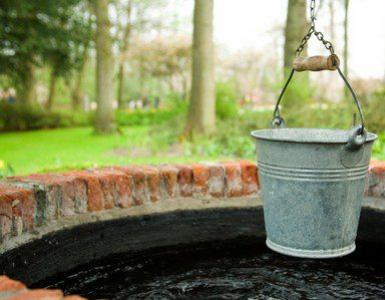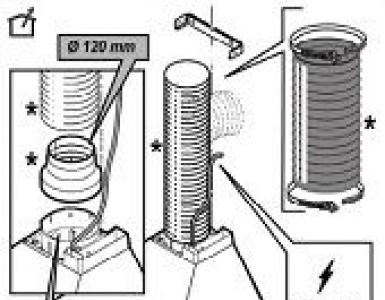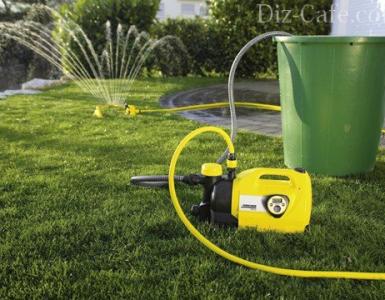What is the difference between interplastic water from groundwater. Aquifer. II. Learning new material
The earth accumulates and retains in the cavities and crevices underground waters replenishing fresh water bodies, their accumulation is vital for supplying water to cities and villages.
Main recruitment resources of underground fresh basins:
- Thawed waters.
- Precipitation.
- Rivers.
Underground basins are considered as ground and interplastic.
Places of formation of groundwater layers:
Groundwater is consumed by any other Bohemia, and more than half of it comes from drinking water. It is the source of the highest quality, because on its way it was exposed to soil and mountain filter. The mountain environment in which it accumulates is thermally stable and partially protects it from direct contamination. But few people, according to geologists, recognize this uniqueness, because most of the population is connected to the water main, where it has good drinking water.
The study focused on the balance of groundwater resources in the areas of water management in the Czech Republic, where groundwater is the only source for municipal and urban water management facilities or where the absorption of groundwater exceeds the abstraction of surface water.
- Areas of glacial shelves.
- Cross-forest massifs.
- River valleys.
- Hollows and hollows in the mountains.
- Sand and pebble layers of rivers flowing in the mountains.
What is the difference between soil sources from interstitial
The surface of the earth is made up of waterproof and water-permeable sedimentary rocks alternating with each other and overlapping unevenly, bends, horizontally or vertically. Water seeping through a water-permeable rock, for example sand, drains onto a layer of clay and accumulates there, forming a layer of groundwater, not covered from above by a water-tight sedimentary rock. Slowly flowing, groundwater pumping through the pores form springs and replenish wells.
In the framework of the study, experts evaluated 58 units, territories that occupy only one third of the territory of the Czech Republic. The rest of the country is still missing. For example, they had to create new geological models of hydrogeological structures and dig out 210 exploration wells to test geological and hydrogeological conditions.
They found out what are the useful reserves of groundwater, in which areas these resources exceed the existing outlets and where, on the other hand, the permissible removals of groundwater already reach critical levels. The study showed that hydrogeological structures with a large number of sandstones a few hundred meters in size can balance the deficit of depletion for several years, in contrast to small structures that depend on the regular replenishment of groundwater, "said Venus.
Interplastic layers of water accumulate in a different way, slowly and for long, as they penetrate into waterproof layers in places where dense soil comes to the surface. In order to extract water lying in impenetrable layers, bore holes, through which water flows under pressure. Interplastic sources of moisture lie deeper than groundwater and are less susceptible to contamination.
The Ministry incurred expenses for geological exploration. M. Czech Institute of Hydrometeorological Data Delivery or Mining University in Ostrava. Climatic conditions have changed over the past 30 years. The air temperature rises, it rains mainly in summer, when vegetation drains a significant part of the rainwater, and it gets worse under the ground or evaporates.
The current drought means that groundwater supplies are inadequate in the regular annual cycle and have been reflected mainly in the lowering of groundwater levels in shallow watercourses. The study also draws attention to the fact that protected areas need waterworks to reduce groundwater so as not to burden protected water ecosystems. The head of the geological service stressed that he had not been involved in the supply of groundwater for the past 20 years.
The depth of the earth's crust is affected by the surface of the earth's crust, if it is divided by beams, rivers, ravines, that is, very uneven, then the level of occurrence of groundwater aquifers is deeper, and they are less polluted.
Interplastic aquifers are more constant and less susceptible to changes than groundwater, they are a valuable source of drinking artesian water, especially where they are knocked out to the surface, forming natural springs, the water of which is considered curative. 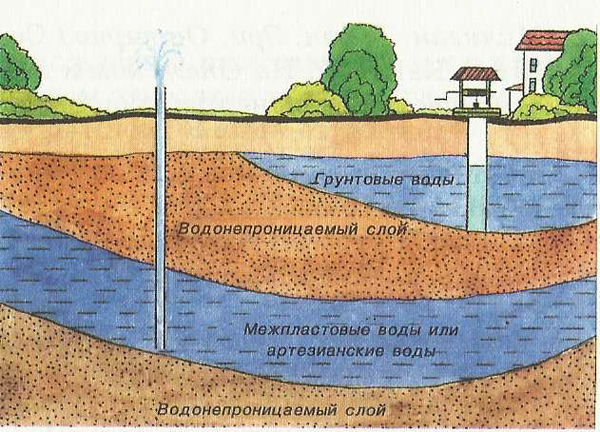
At the same time, as the owner of water, he gives permission to whom and how to dispose of it. One of the measures to increase the supply of groundwater will be artificial irrigation, which, for example, works in the Karana catchment basin, which is a strategic source of drinking water for Prague and Central Bohemia.
The results of the project, according to Brabek, are extremely valuable. They can serve the public administration for monitoring the volume of groundwater and monitoring their condition, thereby serving the water authorities. Surface water differs in many characteristics: its flow and change, temperature, concentration and nature of dissolved or suspended substances, biological and microbiological content, each mass of liquid water with its bedding and its distinctive ecosystem.
Groundwater levels
Accumulating near water bodies, under the surface of the earth, the mass of groundwater forms the so-called mirror or level. In rainy mountain areas with a large amount of precipitation, groundwaters are close to the surface, in arid regions, with low amounts of precipitation and strong evaporation, and the aquifers are deep enough.
At the same time, freshwater waters have many common features: unlike underground waters, they are usually less mineralized, richer in biological elements, more susceptible to other factors, more easily polluted, less stable in their characteristics, but they also have higher automation capabilities their quality.
Underground waters mean water circulating in the pores and cracks of rocks in the earth's crust. Groundwater comes from direct infiltration of atmospheric precipitation, infiltration of surface water through permeable banks of rivers and lakes, condensation of water vapor into the pores of underground rocks.
A valuable source of water is the lenses lying in the layers of aeration, above the main aquifer. Their main drawback is that they easily get dirty and require cleaning.
Lenses accumulate on sand or gravel, if during the excavation of the well to break this layer, the entire lens will drain down and the source will become inaccessible. The determination of the water table is made in the spring, measuring it in test wells or wells.
After creeping and drainage of underground water, underground waterways or watercourses can be. Underground courses in a cracked or carved rock. Low shallow shallow water cantons in granular rocks, not directly under the influence of neighboring surface waters or artificially directed to surface waters.
Lakes deep marine aquifers, cantonate in granular rocks, not exposed to direct exposure to surface water. Sources from underground estuaries due to local geomorphological conditions. The layers of water consist of sand dunes. Groundwater sources may be free or under pressure. The aquifer is free, if during drilling water remains at the level at which it was detected; the deeper layers of the aquifer are usually under pressure, a fact found when drilling is performed by raising water to a level higher than the level at which it was found.
The occurrence of interplastic sources of pure water
The depth of occurrence of an aquifer of pressure or non-pressure may be at a level of ten meters or deeper. Pressure waters are formed in the bends of the crust or in the beds of rocks, they fill the wells under pressure, sometimes they are beaten with a fountain. The pressureless layers are cleaner and have a high quality chemical composition, but it is precisely the non-pressure water that is ideal for water for household purposes.
The underground layer of water is called artesian, if the drilling water naturally reaches the surface of the earth and rises if the water level remains in the drilling under the ground. Underground waters, due to their quality, can be used directly for the purposes of drinking water supply to settlements and food processing units, while surface waters, rivers and lakes, when used, must be treated before use.
Significance and protection of groundwater
Problems with groundwater. Factors affecting the quality of groundwater are largely identical to factors affecting the quality of surface water. Meteorological waters bring dissolved dissolved gases and dissolved minerals. The use of households is directed to underground waters by filtration from septic tanks or sewage collectors, as well as penetration of surface waters, detergents, nitrates, sulfates and other decomposition products of organic substances, salts and dissolved ions from the water supply network and soluble organic compounds.
Pressurized water available for supply to wells is called artesian, they have a permanent chemical and mineral composition. Protected by dense layers of top and bottom artesian sources, which are minerals, are not contaminated with bacteria and microbes, therefore water can be consumed without preliminary cleaning. Detected in inter-soil waters, harmful impurities and microorganisms indicate the fact of pollution by groundwater. 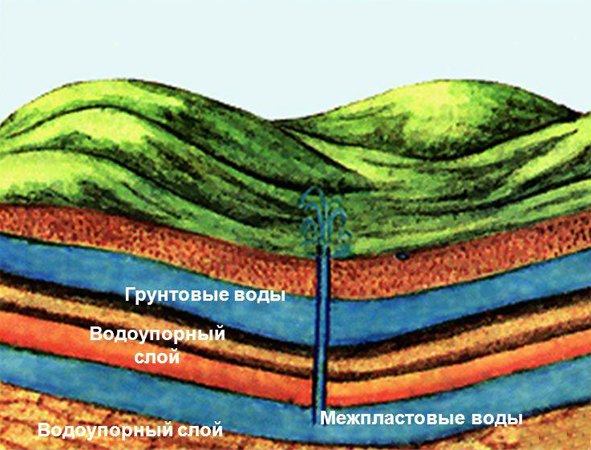
Break through the layers of soil artesian water, can flow to the surface, forming sources of drinking water, without impurities and completely clean in hygienic terms.
Industrial use of water creates a release into the groundwater of various salts dissolved in industrial wastewater that penetrate the soil from contaminated surface water. Agriculture produces salt from irrigation water. There are products of organic decomposition on the landfills, soluble chemicals, soluble gases, ash salts. Pollution of groundwater in Romania is present in a large number of sources that should not be used, but ignorance and the lack of alternatives perpetuate the use of inappropriate fountains and sources.
Interplastic pressure water in large volumes are called artesian basins. Water from them is used for technical and household purposes.
The structure of the artesian basin:
- Area of water intake.
- The pressure part.
- Stoke.
Differences in interplastic and groundwater
Based on the characteristics of underground aquifers, we get an answer to the question: what is the difference between interplastic and groundwater.
In eleven wells with a depth of more than 30 m, the chemical composition of deeper intermoral aquifers was observed. The groundwater pressure trend in the ground layer is observed in many places in Lithuania, which is associated with a decrease in the amount of precipitation in the warm season. The investigated wells include.
Compared with the lowest levels, the groundwater level in Yankysk was the lowest, in the underground cellar of the Upper Panerican - it was on average 0-25 m, and in Bukese - up to 1, 14 m deeper. Here, the water level in the additional aquifer remained on average 5, 1 m higher than in the flowing aquifer. In the general case, in the case of lower wells in water, nitrates occur on average about 8, 5 times more than in deeper layers. By the amount of dissolved salts, groundwater is approximately 1, 6 times more mineralized than water in deeper watercourses. Compared to all wells, where the monitoring program provides for the exploration of metals, their concentration was relatively low. The Reformed Church is still subject to deep water filtration. . In addition, in a deeper well, the chloride concentration is approximately twice as high as in the next.
The main difference between interplastic and groundwater:
- Depth of occurrence.
- Stability of mineral composition.
- Purity.
- Suitability for drinking and cooking.
- Low temperature.
- Travel speed.
- Invariable level.
- Mineralization.
The difference is important for the life of mankind: interplastic water is a valuable source of mineralized, drinking water that does not require additional purification.
The main source of contamination of sodium and chlorine in these wells is the salt used to dissolve the snow. Assessing the fact that these wells also have the highest ammonium content. According to the latter, groundwater is to some extent contaminated in Yankysk. It is likely that in these wells the source of the water chemical components is the same - the salt is used to spread the streets.
These drill holes also contain most of the sodium ions, which is certainly a contaminant salt that is used to dissolve snow. In all samples taken, the values of these pollutants are lower than the limit of the accuracy of their detection methods.
Among the land's waters, the largest reserves are in groundwater, with a total reserve of 60 million km 3. Underground waters can be in a liquid, solid, vaporous state. They are located in the soil and in the rocks of the upper part of the earth's crust.
The ability of rocks to flow water depends on the size and number of pores, voids, cracks.
To compare the quality of groundwater with drinking water needs, limit values were calculated that show how many times the normative value of the indicator has been exceeded or if it has not been exceeded, to what extent it forms a given value. comparison of the following components.
Chlorine, nitrate, sodium, index of permanganate. . In addition, in a deeper well, the chloride concentration is approximately three times higher than in the next one. These holes also found most of the sodium ions, which, of course, is the contamination of the salt used to melt the snow.
In relation to water, all rocks are divided into three groups: permeable (water is well passed), watertight (retard water) and soluble.
Soluble species - it is potassium and salt, gypsum, limestone. When underground waters dissolve them, deep cavities, caves, funnels, and wells are formed at the depth (this phenomenon is called karst).
The quality of water in the well of the city of Vilnius and its change
Chlorine, nitrate, sodium ammonium, specific electrical wire, permanganate index. In most wells, there is no pollution, which exceeds environmental requirements for the management of contaminated sites in wells located in the transport ring between the Green Bridge and the National Opera, with a high level of chlorides, which is 3.5 times the environmental protection requirements for management contaminated sites. Thus, in general, there are hydrochemical data for 25 wells, 11 of which are installed in groundwater, and 14 - in interlayers.
Water-permeable rocks can be divided into two categories: permeable in their entire mass (uniformly permeable) and relatively permeable (semipermeable). Examples of well permeable rocks are gravel, gravel, sand. Semipermeable include fine-grained sand, peat, etc.
In addition, water-permeable rocks can be water-intensive and not water-intensive.
Well water quality in the municipality of Vilnius
The quality of the well water is characterized by indicators of chemical or physical properties of water in accordance with the values of the indicators provided for in the Lithuanian hygiene regulations or other regulatory acts. The quality of the well water is estimated by the maximum chemical and physical components detected within 6 years compared to the normal values.
For comparability, only indicators that have been studied at least once in all wells are given and are relevant at least once within 6 years. Chlorine, sodium, a specific electrical wire, permanganate index, iron and its compounds, manganese and its compounds. The first four are common, the next three are biogenic, the last two are metals.
Low-moisture rocks - this is a rock that freely passes the water without being saturated with it. This, for example, sand, gravel, etc.
Water-intensive - this is a rock that retains some amount of water (for example, one cubic meter of peat retains more than 500 liters of water).
TO watertight mountain rocks include clays, massive crystalline and sedimentary rocks. However, these rocks can be broken by cracks and become permeable in natural conditions.
The layers of waterproof rocks, over which the aquifers lie, waterproof.
On waterproof rocks, the percolating water is retained and fills the gaps between the particles of the overlying permeable rock, forming aquifer.
Layers of water-permeable rocks that contain water are called aquiferous.
On the plains, composed of sedimentary rocks, water-permeable layers and water-resistant layers usually alternate.
Underground waters lie in layers (Fig. 1). They can be divided into three horizons:
- Upper horizon - this fresh water, lying at a depth of 25 to 350 m.
- Average horizon - water, lying at a depth of 50 to 600 m. They are usually mineral, or salty.
- Lower horizon - water, often buried, highly mineralized, is represented by brines. It lies at a depth of 400 to 3000 m.
Deep horizons of water can be juvenile and (magmatic origin) or relic. The water of the lower horizons in most cases was formed during the formation of sedimentary rocks enclosing them.
According to the conditions of occurrence, groundwater is subdivided into soil, perch and water of saturation - ground and interplastic (Figure 2).
Soil water and perchage
Soil water fill part of the gaps between the soil particles. They are necessary for the normal life of plants.
Verkhovodka It is not deep, it exists temporarily, it is not very strong. In our climatic conditions, it appears in the spring after the melting of snow, sometimes in the fall.
Fig. 1. Groundwater layers

Fig. 2. Types of waters according to conditions
Groundwater
Groundwater form an aquifer at the first water-resistant layer from the surface. The surface of groundwater is called a mirror of groundwater. The distance from the groundwater table to the waterproof layer is called the thickness of the waterproof layer.
Groundwater feeds on leaking atmospheric precipitation, waters of rivers, lakes, reservoirs.
In connection with a shallow occurrence from the surface, the groundwater table experiences considerable fluctuations in the seasons of the year: it then rises after precipitation or melting snow, then decreases in dry times. In severe winters, groundwater can freeze.
Since the depth of groundwater is determined primarily by climatic conditions, it varies in different natural zones. So, in the tundra the level of groundwater practically coincides with the surface, and in semi-deserts it is at a depth of 60-100 m, and not everywhere, and these waters do not have sufficient pressure.
A great influence on the depth of occurrence of groundwater renders the degree of dismemberment of the terrain of the territory. The stronger it is, the deeper the groundwater is.
Groundwater is highly susceptible to contamination.
Interplastic water
Interplastic water - Lower aquifers, enclosed between two water-resistant layers. Unlike groundwater, the level of interstitial water is more constant and less varies with time. Interplastic waters are cleaner than groundwater.
A special group of groundwater is pressure interstitial water. They completely fill the aquifer and are under pressure. All waters enclosed in layers lying in concave tectonic structures have a spur.
Opened by the wells and rising upwards, they pour out onto the surface or flow. So arranged artesian wells (Figure 3).
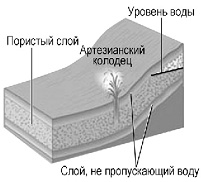
Fig. 3. Artesian well
The chemical composition of groundwater is not the same and depends on the solubility of adjacent rocks. The chemical composition distinguishes between fresh (up to 1 g of salts per liter of water), slightly mineralized (up to 35 g of salt per liter of water) and mineral waters (up to 50 g of salts per liter of water) of groundwater. In this case, the upper horizons of groundwater are usually fresh or slightly mineralized, and the lower horizons can be highly mineralized. Mineral water in its composition can be carbonic, alkaline, ferruginous, etc. Many of them are of therapeutic value.
Groundwater temperature
By temperature, groundwater is divided into cold (up to +20 ° C) and thermal (from +20 to +1000 ° C). Thermal waters usually have a high content of different salts, acids, metals, radioactive and rare earth elements.
Natural outcrops of groundwater (usually groundwater) to the surface of the earth is called sources (springs, keys). They are formed usually in low places, where the terrestrial surface is crossed by aquifers.
Sources are cold (with a water temperature not exceeding 20 ° C), warm (from 20 to 37 ° C) and hot, or thermal (above 37 ° C). Periodically flowing hot springs are called geysers. They are in areas of recent or modern volcanism (Iceland, Kamchatka, New Zealand, Japan).
Significance and protection of groundwater
Underground waters are of great importance in nature: they are the most important source of food, bogs; dissolve various substances in the rocks and transfer them; with their participation karst and landslide forms of relief are formed; when close to the surface can cause waterlogging processes; supply plants with moisture and dissolved in them nutrients, etc. They are widely used by man: they are sources of clean drinking water; are used to treat a number of human diseases; provide the production process with water resources; are used for irrigation of fields; from thermal waters receive a large number of different chemicals (iodine, gauberovu salt, boric acid, various metals); the thermal energy of groundwater can serve to heat buildings, greenhouses, generate electricity, etc.
Today in many regions the state of groundwater is assessed as critical and has a dangerous tendency for further deterioration. Despite the fact that the reserves of groundwater are large, they are renewed very slowly, and this must be taken into account when they are spent. Equally important is the protection of groundwater from pollution.
Underground water (not only superficial, but also deep), following other elements of the environment, is affected by the polluting effect of human economic activity: from mining enterprises, chemical waste and fertilizer storages, landfills, livestock complexes, settlements, etc. Among the substances polluting the underground waters are: oil products, phenols, heavy metals (copper, zinc, lead, cadmium, nickel, mercury), sulfates, chlorides, nitrogen compounds. The areas of foci of groundwater pollution reach hundreds of square kilometers. There is a deterioration in the quality of drinking water.


